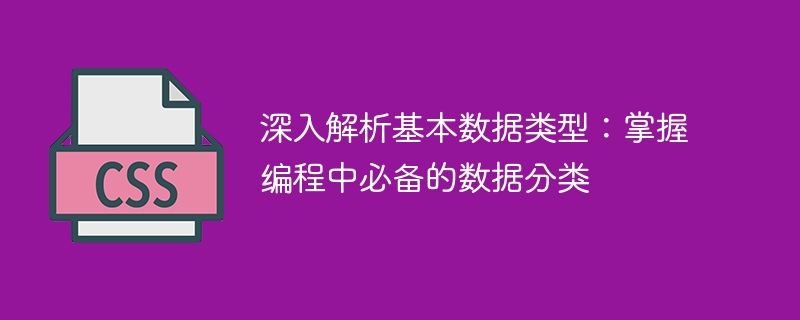
[In-depth analysis of basic data types: Master the necessary data classification in programming]
In computer programming, data is one of the most basic elements. The choice of data types is crucial to the use of programming languages and the design of programs. Among the many data types, basic data types are one of the most basic and commonly used data classifications. By in-depth analysis of basic data types, we can better grasp the necessary data classification in programming.
1. Definition and characteristics of basic data types
Basic data types are the most basic data types provided by programming languages. Different programming languages may have different definitions and naming of basic data types, but they usually include integers, floating point numbers, characters, Boolean values, etc.
- Integer type: used to represent integers, which can be positive integers, negative integers or zero. Depending on the precision, integer types are usually divided into different subtypes, such as byte type, short integer type, integer type, long integer type, etc. The characteristics of the integer type are determined precision and limited value range.
- Floating point number type: used to represent real numbers, that is, values with decimal parts. Usually divided into single-precision floating-point numbers and double-precision floating-point numbers. The characteristic of the floating point number type is that it can represent very large or very small values, but the precision is limited and there is rounding error.
- Character type: used to represent a single character. Different programming languages have different implementations of character types and support for character sets. Character type is characterized by occupying one byte of storage space.
- Boolean type: used to represent true value. There are only two values: true and false. The characteristic of the Boolean type is that it only takes up one byte of storage space.
2. Application scenarios of basic data types
Different basic data types are suitable for different application scenarios. Understanding the characteristics and applicable scenarios of basic data types can better select appropriate data types and improve program efficiency and stability.
- Application scenarios of integer type: Suitable for scenarios that need to represent integers, such as counters, indexes, loop control, etc. Choosing the appropriate integer type according to actual needs can reduce memory usage and increase calculation speed.
- Application scenarios of floating point number type: Suitable for scenarios that need to represent real numbers, such as scientific computing, physical simulation, graphics processing, etc. Due to the limited precision of floating-point number types, scenarios involving precise calculations and comparisons should be used with caution.
- Character type application scenarios: Suitable for scenarios that require processing of text and characters, such as string operations, file reading and writing, user interface, etc. For different programming languages, the way character types are handled and the character sets supported may differ.
- Boolean type application scenarios: Suitable for scenarios that need to represent true values, such as conditional judgments, logical operations, switch control, etc. The value of the Boolean type is simple and clear, which can improve the readability and maintainability of the program.
3. Precautions for basic data types
When using basic data types, you need to pay attention to the following aspects:
- Data overflow: For For integer and floating-point number types, pay attention to the problem of data overflow. When the value range of the data type is exceeded, data overflow may occur, resulting in inaccurate results or program crash.
- Type conversion: Type conversion can be performed between different basic data types. However, accuracy may be lost or data may be lost during the conversion process.
- Character encoding: The way character types are stored and the character sets they support may differ in different programming languages. Pay attention to character encoding issues to avoid garbled characters or character conversion errors.
- Boolean operations: When performing Boolean operations, pay attention to the characteristics of short-circuit operations and operator priority to ensure correct logic and readability of the program.
Summary:
This article helps readers better grasp the necessary data classification in programming through an in-depth analysis of basic data types. Understanding the definitions, characteristics, and application scenarios of basic data types allows you to choose appropriate data types more flexibly and efficiently during the programming process, improving program performance and readability. At the same time, you also need to pay attention to the precautions for using basic data types to avoid potential problems in program design. Through continuous learning and practice, we can better master basic data types and lay a solid foundation for programming.
The above is the detailed content of In-depth analysis of data type classification essential in programming. For more information, please follow other related articles on the PHP Chinese website!






